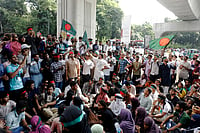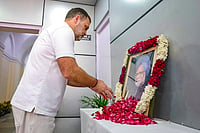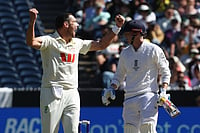AT the Musafirkhana Chowk in the Amethi parliamentary constituency, Congress candidate Satish Sharma makes it a point to urge voters to elect him so that he can keep the seat safe in anticipation of Sonia Gandhi's decision to enter Parliament.
Sharma, for long a Gandhi family servitor in the highest traditions of the Uttar Pradesh Congress, is more than aware that his electoral chances depend on the Gandhi name. He has distributed largesse in Amethi and represented the family well. The rally organised in honour of Sonia last fortnight near Amethi was a grand success; well over a lakh locals, eager to hear more about the exploits and sacrifices of the Gandhi clan, turned up for Sonia's address. And, purely as Congress rallies go, it was a rare sight to see Narain Dutt Tiwari, Jitendra Prasada and Pramod Tewari holding hands under the arclights and media glare.
But once the dust billowing from the two private choppers carrying Sonia, Priyanka and Rahul Gandhi had cleared, Amethi remained at best an oasis for the Congress in Uttar Pradesh, once a bastion of the Congress. Indeed, the state Congress, which resides at Lucknow's Mall Avenue, makes for a most uninspiring sight, with the only visible signs of impending elections being three stalls crammed with posters that could have well belonged to any old campaign.
In fact, the real gnawing battle may well be fought elsewhere—between the BJP and Mulayam Singh Yadav's Samajvadi Party (SP)—far away from any weak and unconvincing Congress assertion that Sonia will win them a poll. In a state where the floating vote is shrinking rapidly, the 'Sonia wave' theory belongs to the realms of political analysis of a different era.
Look at it another way. The real beneficiary of the Mandal recommendations in Uttar Pradesh has been the BJP. While the Janata Dal last week re-asserted its claim on Mandal, it is the BJP which seems to have got its act together, carefully looking at caste equations in each constituency and allotting tickets on that basis. So even while the party invokes Lord Ram in its manifesto, the groundwork seems to suggest due consideration has been given to powerful caste leaders and influential candidates.
The 'historic' nature of the campaign is also not lost on the two main rivals. At a rally in Chandauli near Varanasi, Mulayam, while committing himself to 'Pakistan, Naujawan and Musalman'—an appeal to the youth and Muslims and a reference to his call for an Indo-Pak confederation—readily admits that his fight with the BJP will be extremely significant. A sentiment echoed by archrival Murli Manohar Joshi in Allahabad: "This fight is truly momentous...all we need is a good pitch."
THE campaigns therefore are similarly placed. Says Ram Saran Das, president of the state SP: "Our emphasis this time is on a clever use of the caste equation. We have analysed constituencies, seen what equation suits us." Accordingly, the SP has positioned its candidates. Nowhere is this emphasised better than in Mirzapur, 'Bandit Queen' Phoolan Devi's constituency. Das's prognosis: "Phoolan will have the Muslims, Yadavs, Binds and the other backwards, who are large in numbers."
Or Varanasi, where the SP has left its seat for Dinanath Singh of the CPI(M), who will get the benefit of the same caste equations that are going to have a major impact on voting patterns in eastern Uttar Pradesh which accounts for over 40 seats. In fact, in constituency after constituency, it is the same pattern. In Phoolpur, once represented by Jawaharlal Nehru, the fight is between a Dalit and two Brahmins: Beni Madhav Bind of the BJP against J. B. Patel of the SP and Rampoojan Patel of the BSP. Rampoojan Patel was elected from here in 1991 on a JD ticket, defeating Bind, then of the BSP.
The constituency profile is pretty representative of most of eastern UP; the percentage of Brahmins, Kurmis, Yadavs and Muslims is almost equal so that only a combination of castes can return a candidate to the Lok Sabha. For instance, in Phoolpur, the BJP candidate enjoys the advantage of saffron sympathies in addition to the one lakh Bind voters in the constituency. Hence, often a high caste man is pitted against a backward or Dalit to corner caste votes more blatantly than has been the practice till now.
In the neighbouring Chayal constituency, sitting BJP MP Amritlal Bharti says the party's caste equation is in order: "Sonia will have no impact here. Some emotional appeal for upper caste voters, but not enough to upset well-established applecarts." This optimism cuts across party lines. Says SP worker Rajendra Yadav in Jaunpur: "We will win not just Jaunpur but Saidpur and Machlishahr. This triangular region has a majority of Yadavs, Muslims, Patels and Pasis and they are all coming to us."
On the flip side, upper caste constituencies only have upper caste candidates. Allah-abad, for long regarded as a city of the white-collared intellectual, will see a tussle between the BJP's Joshi and the SP's Shyama Charan Gupta; even the BSP has fielded an upper caste nominee, K.P. Shrivastava. A similar situation prevails in Gazipur.
In such a scenario, the minority vote is likely to go mostly to the Samajvadi party, notwithstanding BJP claims that Muslims, at least some of them, are going to vote for them. As for the Congress, Sonia and Madhavrao Scindia's apology on the Babri Masjid demolition is described as laughable, to say the least. It was best reflected in the Luck-now-based Urdu weekly Nida-e-Millat which declared that Congress attempts to win back Muslim votes with the help of Sonia were just not good enough.
Another influential Urdu paper Sahafat, on the other hand, perceived some clear trends in the BJP victory at the council elections in January: the BSP and Mayavati are on the decline, the spectacular BJP victory is not an accurate assessment of its real strength and the SP remains the only potent force in the state to take on the BJP effectively.
However, the optimism in the BJP camp is understandable. Says party observer for UP S.S. Bhandari, who is predicting an 8 per cent swing in favour of the BJP: "We are looking for a sweep, somewhere in the region of 70 seats." What of the upper caste votes that have swung in for the BJP and Sonia's likely impact, given the success of her Amethi rally? "Sonia's trip was surely a shot in the arm, but what does it mean? You have a good doctor, but the patient is incurable. She will come three or four times to the state then go back," he replies.
So polarised is the vote in this politically crucial state, that there is little to campaign for. Congress flags, for instance, are not visible at all. Articulates party spokesman Ramesh Dixit: "We are trying to revive an organisation that has been damaged badly by casteist and communal forces." Dixit, like most other Congressmen, feels that Sonia's trips to UP are going to revive the organisation. But where is the organisation? Says Sunil Pandey, a former Congress worker in the Rajiv days in Jagdishpur, now a supporter of the BJP: "If Sonia had contested the elections herself, it would be different." And since that was not to be, interest in the Congress remains purely academic.
Meanwhile, anti-BJP forces can draw solace from the fact that Ajit Singh's party is expected to take some seats in western UP's Jat belt, bordering Delhi. Singh has made the right noises about going along with former foe Mulayam, once his father Charan Singh's protege in the UP politics of the '60s and '70s. But whether this would be enough to help the SP stop the saffron juggernaut, only the poll results will tell.


























